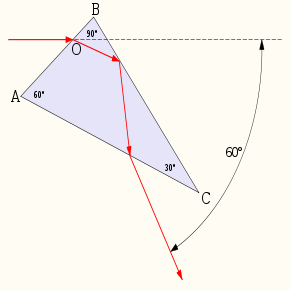
Abbe prism
Encyclopedia
In optics
, an Abbe prism, named for its inventor, the German physicist Ernst Abbe, is a type of constant deviation dispersive
prism
similar to a Pellin–Broca prism.
 The prism consist of a block of glass forming a right prism
The prism consist of a block of glass forming a right prism
with 30°–60°–90° triangular faces. When in use, a beam of light enters face AB, is refracted and undergoes total internal reflection
from face BC, and is refracted again on exiting face AC. The prism is designed such that one particular wavelength
of the light exits the prism at a deviation angle (relative to the light's original path) of exactly 60°. This is the minimum possible deviation of the prism, all other wavelengths being deviated by greater angles. By rotating the prism (in the plane of the diagram) around any point O on the face AB, the wavelength which is deviated by 60° can be selected.
The dispersive Abbe prism should not be confused with the non-dispersive Porro–Abbe or Abbe–Koenig prisms.
Optics
Optics is the branch of physics which involves the behavior and properties of light, including its interactions with matter and the construction of instruments that use or detect it. Optics usually describes the behavior of visible, ultraviolet, and infrared light...
, an Abbe prism, named for its inventor, the German physicist Ernst Abbe, is a type of constant deviation dispersive
Dispersion (optics)
In optics, dispersion is the phenomenon in which the phase velocity of a wave depends on its frequency, or alternatively when the group velocity depends on the frequency.Media having such a property are termed dispersive media...
prism
Prism (optics)
In optics, a prism is a transparent optical element with flat, polished surfaces that refract light. The exact angles between the surfaces depend on the application. The traditional geometrical shape is that of a triangular prism with a triangular base and rectangular sides, and in colloquial use...
similar to a Pellin–Broca prism.
Structure

Prism (geometry)
In geometry, a prism is a polyhedron with an n-sided polygonal base, a translated copy , and n other faces joining corresponding sides of the two bases. All cross-sections parallel to the base faces are the same. Prisms are named for their base, so a prism with a pentagonal base is called a...
with 30°–60°–90° triangular faces. When in use, a beam of light enters face AB, is refracted and undergoes total internal reflection
Total internal reflection
Total internal reflection is an optical phenomenon that happens when a ray of light strikes a medium boundary at an angle larger than a particular critical angle with respect to the normal to the surface. If the refractive index is lower on the other side of the boundary and the incident angle is...
from face BC, and is refracted again on exiting face AC. The prism is designed such that one particular wavelength
Wavelength
In physics, the wavelength of a sinusoidal wave is the spatial period of the wave—the distance over which the wave's shape repeats.It is usually determined by considering the distance between consecutive corresponding points of the same phase, such as crests, troughs, or zero crossings, and is a...
of the light exits the prism at a deviation angle (relative to the light's original path) of exactly 60°. This is the minimum possible deviation of the prism, all other wavelengths being deviated by greater angles. By rotating the prism (in the plane of the diagram) around any point O on the face AB, the wavelength which is deviated by 60° can be selected.
The dispersive Abbe prism should not be confused with the non-dispersive Porro–Abbe or Abbe–Koenig prisms.

